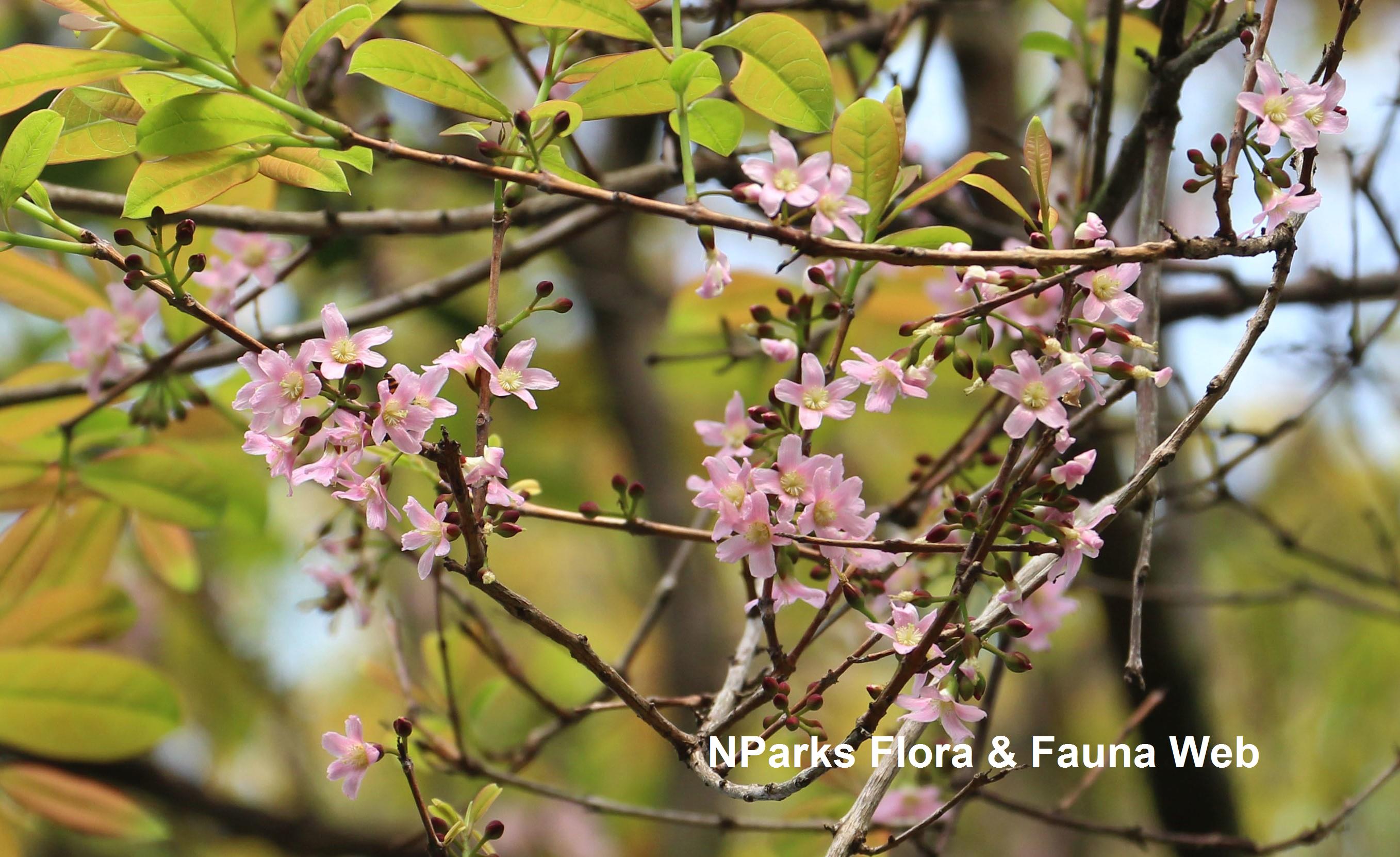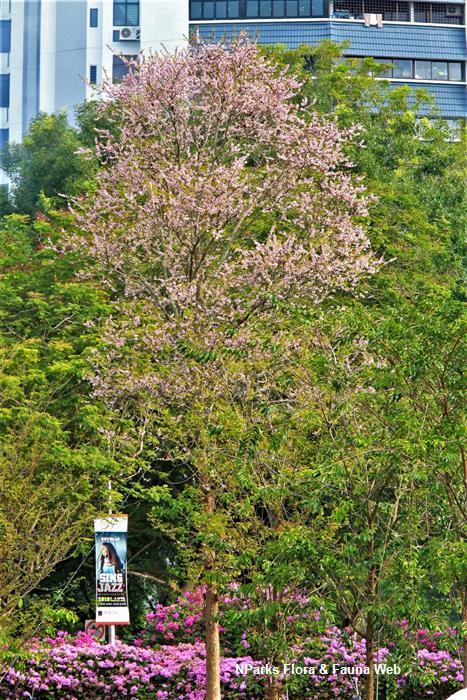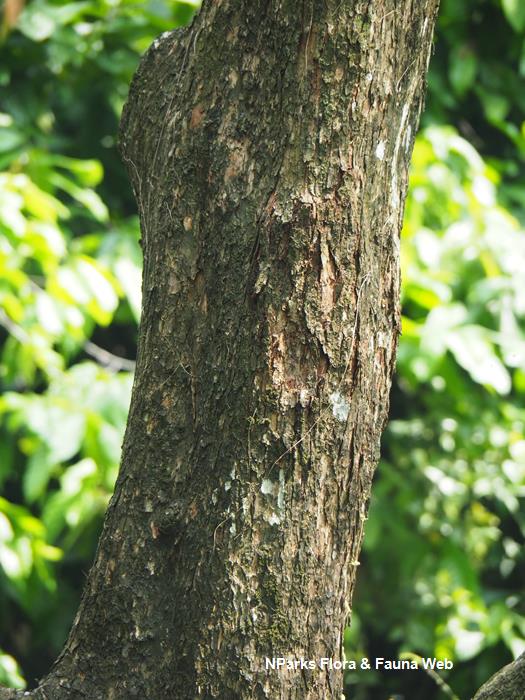
Back
Cratoxylum formosum (Jack) Dyer
| Family Name: | Hypericaceae |
| Common Name: | Pink Mempat, Derum, Mempat, Entemu, Geronggang Biabas, Gerunggung, Kemutul, Kemutun, Mempitis, 越南黄牛木 |
Cratoxylum formosum (Pink Mempat) can grow up to 45 m tall in the wild but is much shorter in cultivation as an ornamental. This tree is native to Singapore and is preferred by the Archduke butterfly caterpillar as a food plant. You can easily spot this beauty when it is in full bloom, with a crown of light-pink flowers nestled among a flush of reddish foliage.
Name
Classifications and Characteristics
| Plant Division | Angiosperms (Flowering Seed Plants) (Dicotyledon) |
|---|---|
| Plant Growth Form | Tree (Big (>30m), Small (6m-15m)) |
| Lifespan (in Singapore) | Perennial |
| Plant Shape | Rounded |
| Maximum Height | 10 m to 45 m |
Biogeography
| Native Distribution | South Andaman Islands, south China, Indochina, south Thailand, Sumatra, Malaysia, Singapore, Bangka Island, the Philippines, Borneo, Java, and Sulawesi |
|---|---|
| Native Habitat | Terrestrial (Primary Rainforest, Secondary Rainforest, Monsoon Forest, Freshwater Swamp Forest, Riverine) |
| Preferred Climate Zone | Tropical, Sub-Tropical / Monsoonal |
| Local Conservation Status | Native to Singapore (Endangered (EN)) |
Description and Ethnobotany
| Growth Form | It is a medium to large-sized tree up to 45 m tall, but in Singapore, it is 10 m or shorter. Its bark is grey and scaly. The plant is easy to spot when its crown is covered with light pink flowers amidst the new foliage. |
|---|---|
| Foliage | Its opposite, long-stalked leaves have fleshy to papery leaf blades that are usually narrowly to broadly oval, and 3.5–18 by 1–7.6 cm. Its new leaves have reddish-pink leaf blades that mature to green above and greenish below. |
| Flowers | Its faintly fragrant flowers are 1.3–2.5 cm wide, with light pink petals. They are found in clusters of 1–6, in axils of fallen leaves or on bare twigs. |
| Fruit | Its dark brown fruits are ellipsoid, 10–19 by 4–6 mm, and split open into three parts when ripe to release the winged seeds. Up to half of the bases of the fruits are covered by the sepals too. Its brownish seeds are narrowly drop-shaped, 6–7.5 by 2–4 mm, and many per fruit. |
| Habitat | It grows in hill, primary or secondary forests, river edges, swamps, and on clay or sandy soils, up to 1,200 m altitude. |
| Associated Fauna | It is the preferred local food plant for caterpillars of the archduke (Lexias pardalis dirteana). The adult of the archduke lays its eggs singly on the undersides of leaves of the host plant. Its flowers are also insect-pollinated. |
| Etymology | Greek kratos, strength; Greek xulon, wood, referring to the strong timber; formosus, beautiful or handsome, referring to this species’ flowers. |
| Ethnobotanical Uses | Edible Plant Parts : Edible Leaves Food (Fruit or Vegetable): The leaves are edible as they are believed to be beneficial for one’s health. Medicinal: Colic and itch is treated by a decoction, and resin from the bark respectively. Skin problems can be treated by applying a pounded mixture of the bark, leaves and coconut oil. Timber & Products: The wood is a commercial source of medium-weight hardwood known as derum. It is used for carving, charcoal, firewood, furniture, house construction, poles and turnery. Cultural / Religious: Heritage Tree: There is currently 2 individual of Cratoxylum formosum listed as Heritage Trees in Singapore. To find out more about these trees, please visit the Heritage Tree Register. |
Landscaping Features
| Landscaping | The plant has attractive new foliage, and light pink, cherry blossom- like flowers. It is suitable for parks and roadsides. It can be propagated by seeds and stem cuttings. In Singapore, only a very low percentage of the seeds develop into seedlings. The saplings must be handled with caution during transplanting, as this species may have thorny stems. Its tolerance for a wide range of soil moisture conditions makes it suitable for damp to sandy sites. |
|---|---|
| Desirable Plant Features | Ornamental Flowers |
| Landscape Uses | Suitable for Roadsides, Parks & Gardens, Small Gardens, Riverine, Shade Providing Tree / Palm |
Fauna, Pollination and Dispersal
| Fauna Pollination Dispersal Associated Fauna | Butterfly Host Plant (Leaves, Associated with: Lexias pardalis) |
|---|---|
| Pollination Method(s) | Biotic (Fauna) (Insects (Butterfly, Moth), Insects (Bee)) |
| Seed or Spore Dispersal | Abiotic |
Plant Care and Propagation
| Light Preference | Full Sun |
|---|---|
| Water Preference | Moderate Water |
| Plant Growth Rate | Moderate |
| Rootzone Tolerance | Moist Soils, Well-Drained Soils, Fertile Loamy Soils, Heavy Clay Soils |
| Propagation Method | Seed, Stem Cutting |
Foliar
| Foliage Retention | Deciduous |
|---|---|
| Mature Foliage Colour(s) | Green |
| Mature Foliage Texture(s) | Papery, Thick |
| Prominent Young Flush Colour(s) | Pink, Red |
| Foliar Type | Simple / Unifoliate |
| Foliar Arrangement Along Stem | Opposite |
| Foliar Attachment to Stem | Petiolate |
| Foliar Shape(s) | Non-Palm Foliage (Oval) |
| Foliar Venation | Pinnate / Net |
| Foliar Margin | Entire |
| Leaf Area Index (LAI) for Green Plot Ratio | 3.0 (Tree - Intermediate Canopy) |
Floral (Angiosperm)
| Flower & Plant Sexuality | Bisexual Flowers |
| Flower Colour(s) | Pink |
|---|---|
| Flower Grouping | Cluster / Inflorescence |
| Flower Location | Axillary |
| Flower Symmetry | Radial |
| Individual Flower Shape | Stellate / Star-shaped |
Fruit, Seed and Spore
| Mature Fruit Colour(s) | Brown |
|---|---|
| Fruit Classification | Simple Fruit |
| Fruit Type | Dehiscent Dry Fruit |
Image Repository
Others
| Master ID | 1537 |
|---|---|
| Species ID | 2830 |
| Flora Disclaimer | The information in this website has been compiled from reliable sources, such as reference works on medicinal plants. It is not a substitute for medical advice or treatment and NParks does not purport to provide any medical advice. Readers should always consult his/her physician before using or consuming a plant for medicinal purposes. |
















.jpg)
